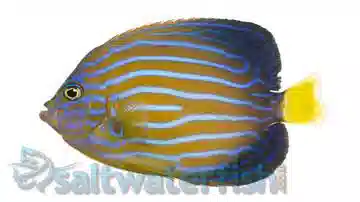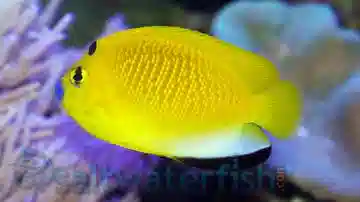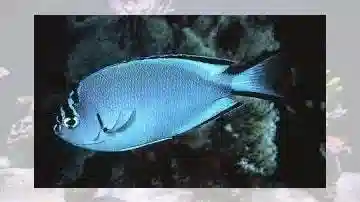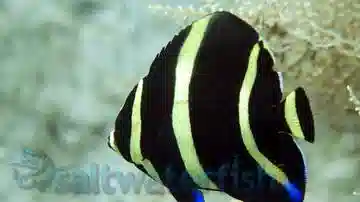Queen Angelfish
Holacanthus ciliaris
(1 Reviews)
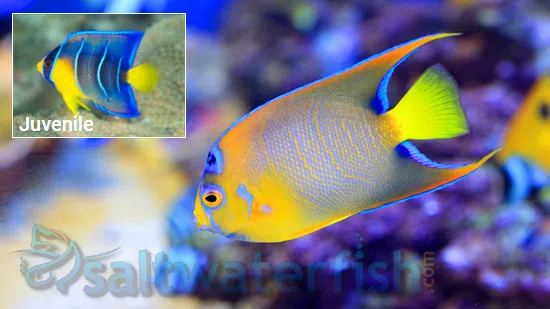
Queen Angelfish
Holacanthus ciliaris
(1 Reviews)
{{ item.name }}
Size: {{ item.extra_field_3 }}
${{ getFormattedPrice(item.saleprice) }} ${{ getFormattedPrice(item.price) }}
To join the waiting list, click here
Free Shipping
With
$199.00
or more in Marine Life.
More details...
Queen Angelfish Care Facts
| Care Level: | Moderate |
|---|---|
| Temperament: | Semi-aggressive |
| Diet: | Omnivore |
| Reef Safe: | No |
| Minimum Tank Size: | 120 gallons |
| Max Size: | 18 inches |
Queen Angelfish (Holacanthus ciliaris): A Comprehensive Guide for Saltwater Aquarium Enthusiasts
Habitat of the Queen Angelfish
The Queen Angelfish are native to the warm tropical waters of the Western Atlantic Ocean. They are commonly found in the Caribbean Sea, the Gulf of Mexico, and parts of Florida. Their natural habitat consists of coral reefs, rocky outcrops, and the crevices and caves within these ecosystems. These structures provide them with shelter and protection.
Is The Queen Angelfish Reef Compatible?
The Queen Angelfish is considered not reef-safe. While they are generally compatible with a reef aquarium, caution is necessary. They may occasionally nip at corals, particularly stony ones, and exhibit territorial behavior as they grow larger. Therefore, careful observation is essential when introducing them to a reef tank with delicate coral species.
How Big Does the Queen Angelfish Get?
One of the defining characteristics of Queen Angelfish is their impressive size. They typically reach 12 to 15 inches (30 to 38 centimeters) when fully grown. Due to their size, providing them with an adequately sized aquarium is crucial for swimming space and growth.
How Long Does the Queen Angelfish Live?
Queen Angelfish can live relatively long lives in captivity with proper care and a suitable environment. On average, they have a lifespan of 10 to 15 years, making them a long-term commitment for aquarium enthusiasts.
What Should the Queen Angelfish Eat?
In their natural habitat, Queen Angelfish have a varied diet. To ensure their health and vitality in captivity, it is essential to replicate this diversity. Their diet should include:
- High-Quality Flakes: High-quality marine flake foods formulated for angelfish should be a staple in their diet.
- Frozen Foods: Provide a variety of frozen foods, including brine shrimp, mysis shrimp, and enriched adult brine shrimp. These foods offer essential nutrients and mimic their natural diet.
- Vegetable Matter: Queen Angelfish also consumes marine algae and plant matter. Include dried seaweed or algae sheets to supplement their diet.
- Live Foods: To replicate their natural foraging behavior, offer occasional live foods such as copepods and amphipods.
The Queen Angelfish's Availability through Aquaculture
Queen Angelfish are not commonly available through aquaculture. Most specimens found in the aquarium trade are sourced from the wild. When acquiring Queen Angelfish, purchasing them from reputable suppliers who adhere to ethical and sustainable collection practices to minimize the impact on wild populations is crucial.
Sexual Dimorphism of the Queen Angelfish
Sexual dimorphism in Queen Angelfish is not easily discernible based on physical characteristics, making it challenging to differentiate between males and females through visual cues.
Symbiotic Relationships of the Queen Angelfish
Queen Angelfish may form symbiotic relationships in their natural habitat with cleaner fish and shrimp. These cleaner species help keep their skin free from parasites by feeding on them. Replicating this relationship in captivity is possible, and some cleaner species can coexist peacefully with Queen Angelfish. However, compatibility should be monitored carefully.
The Queen Angelfish's Coloration Changes Into Adulthood
Juvenile Queen Angelfish are known for their striking and vibrant coloration. They typically exhibit a bright blue body adorned with vivid yellow vertical bars and blue margins on their fins. As they mature into adulthood, their coloration transforms. Adult Queen Angelfish develops a more subdued yet elegant combination of blue, yellow, and black. Their bodies take on a yellow or orange hue, with black margins and blue accents on their fins, creating a visually stunning appearance.
Compatibility of the Queen Angelfish
When considering the addition of a Queen Angelfish to your saltwater aquarium, compatibility with other tank inhabitants is crucial for maintaining a harmonious environment.
The Queen Angelfish's Personality
Queen Angelfish are generally considered semi-aggressive and can become territorial as they grow larger. Therefore, providing ample space and hiding spots is essential to minimize potential conflicts with other fish.
Suitable Tank Mates for the Queen Angelfish
Here are five compatible tank mates that can coexist peacefully with Queen Angelfish:
- Royal Gramma (Gramma loreto): Royal Grammas are peaceful fish that perform well with Queen Angelfish.
- Clownfish (Amphiprion spp.): Clownfish are often compatible with Queen Angelfish, and their symbiotic relationship with anemones adds visual interest to the tank.
- Chromis (Chromis spp.): Chromis species are schooling fish that can coexist with Queen Angelfish, creating a dynamic and visually appealing display.
- Blennies (Blenniidae): Certain blenny species, such as the Midas Blenny (Ecsenius midas), are peaceful and can be suitable tank mates.
- Cleaner Shrimp (Lysmata spp.): Cleaner shrimp can help replicate their natural symbiotic relationships and assist with parasite removal.
Tank Requirements of the Queen Angelfish
Providing a suitable environment is crucial for the health and well-being of Queen Angelfish. Here are detailed tank requirements to consider:
- Minimum Aquarium Size: A spacious aquarium with a minimum capacity of 120 gallons is recommended to provide ample swimming space and accommodate their growth.
- Aquascaping: Create a reef-like environment with live rock structures, caves, and hiding spots. Ensure that there is open swimming space in the center of the tank.
- Filtration: Implement a robust filtration system to maintain excellent water quality. A protein skimmer can help remove organic waste efficiently.
Water Conditions for the Queen Angelfish
- pH: Maintain a stable pH level between 8.1 and 8.4.
- Salinity: Keep the salinity level in the range of 1.020 to 1.025.
- Water Temperature: Maintain a water temperature of 76°F to 80°F (24°C to 27°C).
- Water Flow: Provide moderate to strong water flow to simulate their natural reef habitat.
Other Common Names for the Queen Angelfish
The Queen Angelfish is also known as the Queen Angel.
Why People Should Buy the Queen Angelfish from Saltwaterfish.com
Purchasing a Queen Angelfish from reputable suppliers like Saltwaterfish.com ensures you acquire a healthy and ethically sourced specimen. These suppliers prioritize the well-being of marine life and follow responsible and sustainable practices. Supporting ethical suppliers benefits the aquarist and contributes to the conservation of marine ecosystems and the reduction of the aquarium trade's impact on wild populations.
In conclusion, the Queen Angelfish (Holacanthus ciliaris) is a captivating addition to saltwater marine aquariums, known for its stunning coloration and striking presence. By adhering to the guidelines outlined in this comprehensive guide and sourcing these angelfish from ethical suppliers, aquarists can enjoy the company of this remarkable species while promoting responsible and sustainable practices within the hobby.
Good price, fast shipment of my Queen Angelfish.
Reviewed by: William Nottingham on Sept. 11, 2021


